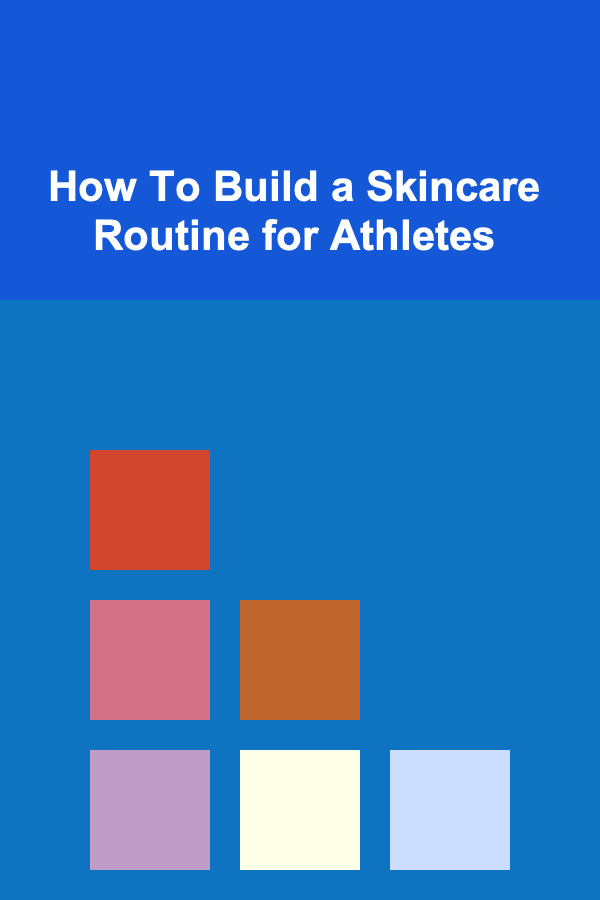
How To Build a Skincare Routine for Athletes
ebook include PDF & Audio bundle (Micro Guide)
$12.99$8.99
Limited Time Offer! Order within the next:

Athletes put their bodies through intense physical stress on a regular basis. From grueling training sessions to competitions, the demands of sports can take a toll on the skin. While the focus for many athletes is on performance, it's equally important to care for the skin, as it is the body's largest organ and one of the most exposed to environmental factors such as sweat, sun, wind, and pollutants. Building a skincare routine for athletes requires understanding the unique needs of the skin under such conditions and incorporating products that protect, hydrate, and repair.
In this comprehensive guide, we will explore how athletes can build an effective skincare routine tailored to their specific needs.
The Importance of Skincare for Athletes
Athletes are prone to skin issues due to the physical demands of their sport, environmental exposure, and the sweat they generate during workouts or competitions. Without proper skincare, issues like acne, irritation, and premature aging can become common. Here's why skincare matters for athletes:
1. Sweat and Skin Irritation
Sweating is a natural bodily response during physical activity, but when sweat sits on the skin for too long, it can clog pores and lead to irritation or acne. Additionally, constant friction from clothing or equipment can cause rashes, chafing, or blisters.
2. Exposure to Environmental Elements
Athletes who train outdoors, particularly those who run, cycle, or participate in outdoor sports, face regular exposure to the sun, wind, and pollution. UV rays can damage the skin, while wind and pollutants can dry out and irritate the skin's protective barrier.
3. Physical Stress
Intense physical exertion increases blood flow to the skin and often causes redness or irritation. Additionally, the stress placed on the body during exercise can also lead to accelerated aging and compromised skin health over time if not properly cared for.
4. Skin Recovery
After a long workout or competition, the skin can feel depleted and fatigued, just like the muscles. Restorative skincare helps in recovery, ensuring the skin remains healthy, hydrated, and resilient.
Understanding Athlete-Specific Skin Concerns
Before diving into a specific skincare routine, it's important to understand the skin concerns that athletes face, as they differ significantly from the average individual's skin needs. These concerns can be addressed by products that balance the skin's natural oils, replenish hydration, and provide protection from environmental elements.
1. Acne and Breakouts
Athletes are more prone to acne because of increased sweating and friction. Sweat, combined with dirt, bacteria, and the use of sports gear (like helmets or pads), can clog pores and cause acne outbreaks, particularly in the areas where equipment touches the skin (e.g., chin, forehead, and neck).
2. Sunburn and Hyperpigmentation
For outdoor athletes, sun protection is critical. Continuous exposure to harmful UV rays can lead to sunburn, premature aging, and even skin cancer. Athletes also experience uneven skin tones and hyperpigmentation as a result of chronic sun exposure.
3. Dryness and Dehydration
While excessive sweating is common, it can lead to dehydration of the skin. Sweat evaporates moisture from the skin, and without proper hydration, the skin can become dry, flaky, and irritated. This is particularly true in athletes who train in cold or windy conditions.
4. Chafing and Rashes
The constant movement, friction, and sweating from physical activity can lead to chafing, particularly in areas where skin rubs against clothing or gear. This is common in long-distance runners, cyclists, and those in contact sports. Rashes and blisters are other common issues that athletes must address.
Step-by-Step Guide to Building a Skincare Routine for Athletes
Step 1: Cleansing -- Keeping Skin Fresh and Clear
The first and most important step in any skincare routine is cleansing. For athletes, this step is particularly important to remove sweat, dirt, bacteria, and impurities that accumulate during physical activity. The right cleanser will not only remove dirt but also maintain the skin's natural balance.
Choosing the Right Cleanser
- Gel or Foaming Cleansers: These are ideal for athletes who sweat heavily. They help to deep-clean the skin without over-drying it.
- Gentle Cream Cleanser: For athletes with sensitive or dry skin, a cream-based cleanser can help maintain hydration while still cleansing effectively.
- Exfoliating Cleanser (used sparingly): Exfoliation helps to remove dead skin cells and unclog pores, preventing acne. However, athletes should avoid over-exfoliating as it can irritate the skin.
When to Cleanse
- After exercise: Cleanse your skin immediately after a workout or competition to remove sweat, oil, and impurities before they can cause breakouts or irritation.
- Before bedtime: Cleanse before bed to remove any leftover impurities from the day.
Step 2: Toning -- Balancing the Skin's pH Levels
Toning helps to refresh and balance the skin's pH levels, which can be disrupted by sweat, exercise, and the environment. A good toner can also help to minimize pores and remove any leftover dirt or impurities that were not fully removed during cleansing.
Choosing the Right Toner
- Alcohol-Free Toner: Look for toners that are alcohol-free, as alcohol can dry out and irritate the skin, especially after sweating.
- Astringent Toner with Salicylic Acid: If you're prone to acne, a toner containing salicylic acid can help treat and prevent breakouts by unclogging pores.
When to Tone
- After cleansing: Use toner immediately after cleansing to prepare the skin for hydration.
Step 3: Moisturizing -- Hydration Is Key
Moisturizing is a critical step, especially for athletes who engage in strenuous physical activities. Sweat can strip the skin of its natural moisture, so replenishing hydration is essential to maintaining skin health and preventing dryness or irritation.
Choosing the Right Moisturizer
- Non-Comedogenic Moisturizers: Opt for a lightweight, non-comedogenic moisturizer that won't clog pores. Gel-based moisturizers are often a good choice for athletes with oily or acne-prone skin.
- Rich, Emollient Moisturizers: For athletes in colder climates or those with dry skin, a heavier, more emollient moisturizer may be necessary to lock in hydration and prevent dryness.
When to Moisturize
- Immediately after cleansing: Apply moisturizer while your skin is still damp to lock in hydration.
- Throughout the day: If your skin feels dry or tight after a workout or during outdoor training, reapply moisturizer to keep the skin soft and hydrated.
Step 4: Sun Protection -- Shielding Skin from UV Damage
Athletes who train or compete outdoors must prioritize sun protection to prevent sunburn and long-term skin damage, including premature aging and skin cancer. Sunscreen is an essential step in any skincare routine, and it is particularly crucial for athletes.
Choosing the Right Sunscreen
- Broad-Spectrum Sunscreen: Choose a sunscreen with broad-spectrum protection, which protects against both UVA and UVB rays.
- SPF 30 or Higher: Select a sunscreen with an SPF of at least 30, and consider SPF 50 for extended outdoor activities.
- Water-Resistant Sunscreen: Athletes who sweat heavily should opt for a water-resistant sunscreen to ensure it stays on the skin during physical activity.
When to Apply Sunscreen
- 30 Minutes Before Activity: Apply sunscreen at least 30 minutes before heading outdoors to allow it to absorb into the skin.
- Reapply Every Two Hours: Reapply sunscreen every two hours, especially if you've been sweating or wiping your face.
Step 5: Spot Treatments -- Targeting Specific Skin Issues
Athletes can suffer from acne breakouts or irritation in specific areas, especially where gear and clothing cause friction. Spot treatments can help address these issues.
Choosing the Right Spot Treatment
- Benzoyl Peroxide or Salicylic Acid: These ingredients are effective in treating acne by killing bacteria and clearing clogged pores.
- Aloe Vera or Hydrocortisone: For irritation, chafing, or rashes caused by friction, aloe vera gel or hydrocortisone cream can provide soothing relief.
When to Use Spot Treatments
- As Needed: Apply spot treatments only to affected areas. Avoid applying them to the entire face as they may be too strong for general use.
Step 6: Restorative Care -- Skin Recovery
After intense physical activity, the skin needs time to recover. A restorative skincare treatment can help rejuvenate the skin, promote healing, and reduce signs of fatigue.
Choosing the Right Restorative Products
- Hydrating Masks: Use hydrating masks that provide a boost of moisture and repair the skin after heavy sweating.
- Anti-Inflammatory Serums: Look for serums that contain anti-inflammatory ingredients like niacinamide, which help reduce redness and calm irritated skin.
When to Use Restorative Care
- Once or Twice a Week: Use hydrating or anti-inflammatory masks once or twice a week to promote recovery after intense training sessions.
Conclusion
Building a skincare routine for athletes requires a holistic approach that addresses the unique challenges posed by intense physical activity, environmental exposure, and frequent sweat. By selecting the right products and following a consistent skincare routine, athletes can ensure their skin remains healthy, protected, and rejuvenated.
A successful athlete's skincare routine should include cleansing, toning, moisturizing, sun protection, spot treatments, and restorative care. The right combination of products will help combat issues like acne, irritation, dehydration, and sun damage. By prioritizing skin health, athletes can focus on their performance while maintaining a clear, glowing complexion.

How to Incorporate Holiday-Themed Fabrics into Your Home Decor
Read More
How to Sell Digital Products Successfully for Absolute Beginners
Read More
Turning Your Deep Learning Expertise into Passive Income
Read More
Why Organizing Your Child's Homework Space Encourages Success
Read More
How to Manage Sports Performance Anxiety
Read More
How To Discuss a Movie's Sound Design
Read MoreOther Products

How to Incorporate Holiday-Themed Fabrics into Your Home Decor
Read More
How to Sell Digital Products Successfully for Absolute Beginners
Read More
Turning Your Deep Learning Expertise into Passive Income
Read More
Why Organizing Your Child's Homework Space Encourages Success
Read More
How to Manage Sports Performance Anxiety
Read More